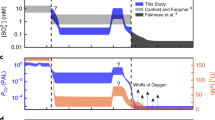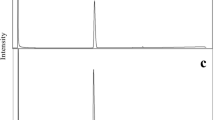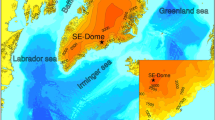Abstract
Carbonyl sulfide (COS) mixing ratioswere measured in the marine atmosphere and in airequilibrated with surface sea water during severalcruises in the North Sea and western NorthAtlantic. In April 1994, North Sea waters weresupersaturated with respect to the atmosphere,resulting in oceanic emissions of COS. Saturationratios varied between the equilibrium value of one inthe central North Sea and high values of >15 in theElbe Estuary. We observed weak diel cycles of surfacewater COS during a three day drift station. During theunderway parts of the cruise, diel COS variations weremasked by the high geographical variability of COSconcentrations in the German Bight. In August 1994, weobserved a pronounced diel cycle of COS off theFlorida coast with saturation ratios varying betweenthe equilibrium value of one in the early morning andmaximum values of four to five in the afternoon. InMarch 1995, we found COS supersaturation as well asextensive undersaturation in the western NorthAtlantic between Norfolk, VA, and Bermuda. Suchundersaturation in marine surface waters results inregional and seasonal uptake of atmospheric COS. Basedon our data and those of other researchers, weestimate the global oceanic COS net emission to bebetween 1.3 and 2.5 Gmol yr-1. This estimate is significantly smaller than previous ones which had notconsidered the possibility of COS uptake by theoceans. COS hydrolysis in the ocean has a significantinfluence on the atmospheric turnover time of COS,which we estimate to be 5.7 yr. This may contribute tothe lack of an observable increase in atmospheric COSlevels despite substantial anthropogenic emissions.
Similar content being viewed by others
References
Andreae M. O. and Crutzen P. J. (1997) Atmospheric aerosols: Biogeochemical sources and role in atmospheric chemistry. Science 276, 1,052–1,056.
Andreae M. O. and Ferek R. J. (1992) Photochemical production of carbonyl sulfide in seawater and its emission to the atmosphere. Global Biogeochem. Cycles 6, 175–183.
Bandy A. R., Thornton D. C., Scott D. L., Lalevic M., Levin E. E. and Driedger III A. R. (1992) A time series for carbonyl sulfide in the northern hemisphere. J. Atmos. Chem. 14, 527–534.
Barnes I., Becker K. H. and Patroescu I. (1994) The tropospheric oxidation of dimethyl sulfide: A new source of carbonyl sulfide. Geophys. Res. Lett. 21, 2,389–2,392.
Bates T. S., Cline J. D., Gammon R. H. and Kelly-Hansen S. R. (1987) Regional and seasonal variations in the flux of oceanic dimethylsulfide to the atmosphere. J. Geophys. Res. 92, 2,930–2,938.
Bingemer H. G., Bürgermeister S., Zimmermann R. L. and Georgii H.-W. (1990) Atmospheric OCS: evidence for a contribution of anthropogenic sources? J. Geophys. Res. 95, 20,617–20,622.
Blough N. V., Zafiriou O. C. and Bonilla J. (1993) Optical absorption spectra of waters from the Orinoco river outflow: Terrestrial input of colored organic matter to the Caribbean. J. Geophys. Res. 98, 2,271–2,278.
Butler J. H. (1994) The potential role of the ocean in regulating atmospheric CH3Br. Geophys. Res. Let. 21, 185–188.
Butler J. H., Elkins J. H., Brunson C. M., Egan K. B., Thompson T. M., Conway T. J. and Hall B. D. (1988) Trace gases in and over the West Pacific and East Indian Oceans during the El Niño-Southern Oscillation event of 1987. NOAA Data Report ERL ARL-16, Air Resources Laboratory, Silver Spring, MD.
Chin M. and Davis D. D. (1993) Global sources and sinks of OCS and CS2 and their distribution. Global Biogeochem. Cycles 7, 321–337.
Chin M. and Davis D. D. (1995) A reanalysis of carbonyl sulfide as a source of stratospheric background sulfur aerosol. J. Geophys. Res 100, 8,993–9,005.
Crutzen P.J. (1976) The possible importance of CSO for the sulfate layer of the stratosphere. Geophys. Res. Lett. 3, 73–76.
de Souza Sierra M. M., Donard O. F. X., Lamotte M., Belin C. and Ewald M. (1994) Fluorescence spectroscopy of coastal and marine waters. Mar. Chem. 47, 127–144.
Donard O. F. X., Lamotte M., Belin C. and Ewald M. (1989) High-sensitivity fluorescence spectroscopy of Mediterranean waters using a conventional or a pulsed laser excitation source. Mar. Chem. 27, 117–136.
Elliott S., Lu E. and Rowland F. S. (1989) Rates and mechanisms for the hydrolysis of carbonyl sulfide in natural waters. Environ. Sci. Technol. 23, 458–461.
Engel A. and Schmidt U. (1994) Vertical profile measurements of carbonylsulfide in the stratosphere. Geophys. Res. Lett. 21, 2,219–2,222.
Fahey D. W., S. R. Kawa, Woodbridge E. L., Tin P. and Co-authors (1993) In situ measurements constraining the role of sulphate aerosols in mid-latitude ozone depletion. Nature 363, 509–514.
Ferek R. J. and Andreae M. O. (1983) The supersaturation of carbonyl sulfide in surface waters of the Pacific Ocean off Peru. Geophys. Res. Lett. 10, 393–396.
Ferek R. J. and Andreae M. O. (1984) Photochemical production of carbonyl sulfide in marine surface waters. Nature 307, 148–150.
Flöck O. and Andreae M. O. (1996) Photochemical and non-photochemical formation and destruction of carbonyl sulfide and methyl mercaptan in ocean waters. Mar. Chem. 54, 11–26.
Hoyt S. D. and Rasmussen R. A. (1985) Determining trace gases in air and seawater. Adv. Chem. Ser., pp. 31–56., Washington, DC.
Johnson J. E. (1981) The lifetime of carbonyl sulfide in the troposphere. Geophys. Res. Lett. 8, 934–940.
Johnson J. E., Bandy A. R., Thornton D. C. and Bates T. S. (1993) Measurements of atmospheric carbonyl sulfide during the NASA Chemical Instrumentation Test and Evaluation Project: implications for the global COS budget. J. Geophys. Res. 98, 23,443–423,448.
Johnson J. E. and Harrison H. (1986) Carbonyl sulfide concentrations in the surface waters and above the Pacific Ocean. J. Geophys. Res. 91, 7,883–7,888.
Kantha L. H. and Clayson C. A. (1994) An improved mixed layer model for geophysical applications. J. Geophys. Res. 99, 25,235–25,266.
Khalil M. A. K. and Rasmussen R. A. (1984) Global sources, lifetimes and mass balances of carbonyl sulfide (OCS) and carbon disulfide (CS2) in the earth's atmosphere. Atmos. Environ. 18, 1,805–1,813.
Laane R. W. P. M. and Kramer K. J. M. (1990) Natural fluorescence in the North Sea and its major estuaries. Neth. J. Sea Res. 26, 1–9.
Lehmann S. and Conrad R. (1996) Characteristics of turnover of carbonyl sulfide in four different soils. J. Atmos. Chem. 23, 193–207.
Levitus S. (1982) Climatological atlas of the world ocean. NOAA Prof. Pap. 13, National Oceanic and Atmospheric Administration, Washington, D.C.
Li Y. H., Peng T. H., Broecker W. S. and Ostlund H. G. (1984) The average vertical mixing coefficient for the oceanic thermocline. Tellus 36B, 212–217.
Liss P. S. and Merlivat L. (1986) Air-sea gas exchange rates: Introduction and synthesis. in: The Role of Air-Sea Exchange in Geochemical Cycling (ed. P. Buat-Ménard), D. Reidel Publishing Company, New York, pp. 113–127.
Mihalopoulos N., Nguyen B. C., Putaud J. P. and Belviso S. (1992) The oceanic source of carbonyl sulfide (COS). Atmos. Environ. 26, 1,381–1,394.
Rasmussen R. A., Khalil M. A. K. and Hoyt S. D. (1982) The oceanic source of carbonyl sulfide (OCS). Atmos. Environ. 16, 1,591–1,594.
Rinsland C. P., Zander R., Mahieu E., Demoulin P., Goldman A., Ehhalt D. H. and Rudolph J. (1992) Ground-based infrared measurements of carbonyl sulfide total column abundances: long-term trends and variability. J. Geophys. Res. 97, 5,995–6,002.
Rodriguez J. M., Ko M. K. W. and Sze N. D. (1991) Role of heterogeneous conversion of N2O5 on sulphate aerosols in global ozone losses. Nature 352, 134–137.
Siedler G. and Peters H. (1986) Properties of sea water. in: Landolt-Börnstein, Oceanography (ed. J. Sündermann), Vol. V/3a, Springer Verlag, Berlin, pp. 233–264.
Solomon S., Sanders R. W., Garcia R. R. and Keys J. G. (1993) Increased chlorine dioxide over Antarctica caused by volcanic aerosols from Mount Pinatubo. Nature 363, 245–248.
Sze N. D. and Ko M. K. W. (1979) CS2and COS in the stratospheric sulfur budget. Nature 280, 308–310.
Trenberth K. E., Large W. G. and Olson J. G. (1989) The effective drag coefficient for evaluating wind stress over the oceans. J. Clim. 2, 1,507–1,516.
Turco R. P., Whitten R. C. and Toon O. B. (1982) Stratospheric aerosols: observation and theory. Rev. Geophys. Space Phys. 20, 233–279.
Turco R. P., Whitten R. C., Toon O. B., Pollack J. B. and Hamill P. (1980) OCS, stratospheric aerosols and climate. Nature 283, 283–286.
Turner S. M. and Liss P. S. (1985) Measurements of various sulphur gases in a coastal marine environment. J. Atmos. Chem. 2, 223–232.
Uher G. (1994) Photochemische Produktion von Carbonylsulfid (COS) im Oberflächenwasser der Ozeane: Prozeßstudien und ein empirisches Modell. Ph. D. thesis, Johannes-Gutenberg-Universität, Mainz, 147 pp.
Uher G. and Andreae M. O. (1996) Photochemical production of carbonyl sulfide in North Sea water: A process study. Linmol. Oceanogr., in press.
Ulshöfer V.S. (1995) Photochemische Produktion von Carbonylsulfid im Oberflächenwasser der Ozeane und Gasaustausch mit der Atmosphäre. Ph. D. thesis, Ruprecht-Karls-Universität, Heidelberg, 160 pp.
Ulshöfer V.S., Flöck O.R., Uher G. and Andreae M.O. (1996) Photochemical production and air-sea exchange of carbonyl sulfide in the eastern Mediterranean Sea. Mar. Chem. 53, 25–39.
Ulshöfer V.S., Uher G. and Andreae M.O. (1995a) Evidence for a winter sink of atmospheric carbonyl sulfide in the northeast Atlantic Ocean. Geophys. Res. Lett. 22, 2,601–2,604.
Ulshöfer V.S., Uher G. and Andreae M.O. (1995b) The seasonal cycle of carbonyl sulfide in surface waters of the northeast Atlantic Ocean: measurements and model calculations. Annales Geophysicae, Supplement II to Volume 13, C395 (abstr.).
Wanninkhof R. (1992) Relationships between wind speed and gas exchange over the ocean. J. Geophys. Res. 97, 7,373–7,382.
Weiss P. S., Andrews S. S., Johnson J. E. and Zafiriou O.C. (1995a) Photoproduction of carbonyl sulfide in south Pacific Ocean waters as a function of irradiation wavelength. Geophys. Res. Lett. 22, 215–218.
Weiss P. S., Johnson J. E., Gammon R. H. and Bates T. S. (1995b) Reevaluation of the open ocean source of carbonyl sulfide to the atmosphere. J. Geophys. Res. 100, 23,083–23,092.
Wilke C. R. and Chang P. (1955) Correlation of diffusion coefficients in dilute solutions. A. I. Ch. E. Journal 1, 264–271.
Zepp R. G. and Andreae M. O. (1994) Factors affecting the photochemical production of carbonyl sulfide in seawater. Geophys. Res. Lett. 21, 2,813–2,816.
Author information
Authors and Affiliations
Rights and permissions
About this article
Cite this article
Ulshöfer, V., Andreae, M. Carbonyl Sulfide (COS) in the Surface Ocean and the Atmospheric COS Budget. Aquatic Geochemistry 3, 283–303 (1997). https://doi.org/10.1023/A:1009668400667
Issue Date:
DOI: https://doi.org/10.1023/A:1009668400667




